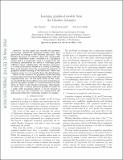| dc.contributor.author | Bresler, Guy | |
| dc.contributor.author | Gamarnik, David | |
| dc.contributor.author | Shah, Devavrat | |
| dc.date.accessioned | 2015-09-18T16:39:39Z | |
| dc.date.available | 2015-09-18T16:39:39Z | |
| dc.date.issued | 2014-09 | |
| dc.identifier.isbn | 978-1-4799-8009-3 | |
| dc.identifier.uri | http://hdl.handle.net/1721.1/98837 | |
| dc.description.abstract | In this paper we consider the problem of learning undirected graphical models from data generated according to the Glauber dynamics. The Glauber dynamics is a Markov chain that sequentially updates individual nodes (variables) in a graphical model and it is frequently used to sample from the stationary distribution (to which it converges given sufficient time). Additionally, the Glauber dynamics is a natural dynamical model in a variety of settings. This work deviates from the standard formulation of graphical model learning in the literature, where one assumes access to i.i.d. samples from the distribution. Much of the research on graphical model learning has been directed towards finding algorithms with low computational cost. As the main result of this work, we establish that the problem of reconstructing binary pairwise graphical models is computationally tractable when we observe the Glauber dynamics. Specifically, we show that a binary pairwise graphical model on p nodes with maximum degree d can be learned in time f(d)p[superscript 3] log p, for a function f(d), using nearly the information-theoretic minimum possible number of samples. There is no known algorithm of comparable efficiency for learning arbitrary binary pairwise models from i.i.d. samples. | en_US |
| dc.description.sponsorship | National Science Foundation (U.S.) (Grant CMMI-1335155) | en_US |
| dc.description.sponsorship | National Science Foundation (U.S.) (Grant CNS-1161964) | en_US |
| dc.description.sponsorship | United States. Army Research Office. Multidisciplinary University Research Initiative (Award W911NF-11-1-0036) | en_US |
| dc.language.iso | en_US | |
| dc.publisher | Institute of Electrical and Electronics Engineers (IEEE) | en_US |
| dc.relation.isversionof | http://dx.doi.org/10.1109/ALLERTON.2014.7028584 | en_US |
| dc.rights | Creative Commons Attribution-Noncommercial-Share Alike | en_US |
| dc.rights.uri | http://creativecommons.org/licenses/by-nc-sa/4.0/ | en_US |
| dc.source | arXiv | en_US |
| dc.title | Learning graphical models from the Glauber dynamics | en_US |
| dc.type | Article | en_US |
| dc.identifier.citation | Bresler, Guy, David Gamarnik, and Devavrat Shah. “Learning Graphical Models from the Glauber Dynamics.” 2014 52nd Annual Allerton Conference on Communication, Control, and Computing (Allerton) (September 2014). | en_US |
| dc.contributor.department | Massachusetts Institute of Technology. Department of Electrical Engineering and Computer Science | en_US |
| dc.contributor.department | Sloan School of Management | en_US |
| dc.contributor.mitauthor | Bresler, Guy | en_US |
| dc.contributor.mitauthor | Gamarnik, David | en_US |
| dc.contributor.mitauthor | Shah, Devavrat | en_US |
| dc.relation.journal | Proceedings of the 2014 52nd Annual Allerton Conference on Communication, Control, and Computing (Allerton) | en_US |
| dc.eprint.version | Author's final manuscript | en_US |
| dc.type.uri | http://purl.org/eprint/type/ConferencePaper | en_US |
| eprint.status | http://purl.org/eprint/status/NonPeerReviewed | en_US |
| dspace.orderedauthors | Bresler, Guy; Gamarnik, David; Shah, Devavrat | en_US |
| dc.identifier.orcid | https://orcid.org/0000-0001-8898-8778 | |
| dc.identifier.orcid | https://orcid.org/0000-0003-0737-3259 | |
| dc.identifier.orcid | https://orcid.org/0000-0003-1303-582X | |
| mit.license | OPEN_ACCESS_POLICY | en_US |
| mit.metadata.status | Complete | |
